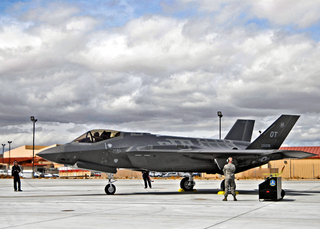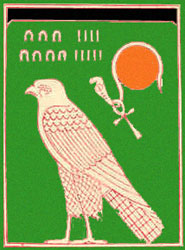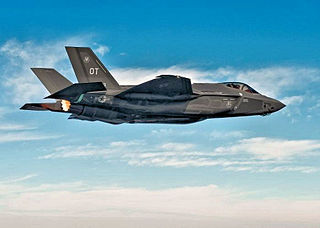| 53d Test and Evaluation Group | |
|---|---|
 53d Wing Emblem The group uses this emblem with the group designation on the scroll | |
| Active | 1942–1947, 1955-1960, 1988–present |
| Country | |
| Branch | Air Force |
| Role | test and evaluation |
| Part of | 53d Wing |
| Headquarters | Nellis AFB |
| Engagements | Mediterranean Theater of Operations World War II Army of Occupation |
| Decorations | Distinguished Unit Citation Air Force Outstanding Unit Award Air Force Organizational Excellence Award |
| Aircraft flown | |
| Attack | A-10 |
| Bomber | B-1, B-2, B-52 |
| Fighter | F-15C & E, F-16, F-22 |
| Multirole helicopter | HH-60 |
| Reconnaissance | MQ-1, RQ-4, U-2 |
The 53d Test and Evaluation Group is a group of the United States Air Force. It is a part of the 53d Wing, and is headquartered at Nellis AFB, Nevada. [1]

The United States Air Force (USAF) is the aerial and space warfare service branch of the United States Armed Forces. It is one of the five branches of the United States Armed Forces, and one of the seven American uniformed services. Initially formed as a part of the United States Army on 1 August 1907, the USAF was established as a separate branch of the U.S. Armed Forces on 18 September 1947 with the passing of the National Security Act of 1947. It is the youngest branch of the U.S. Armed Forces, and the fourth in order of precedence. The USAF is the largest and most technologically advanced air force in the world. The Air Force articulates its core missions as air and space superiority, global integrated intelligence, surveillance, and reconnaissance, rapid global mobility, global strike, and command and control.

The 53d Wing is a wing of the United States Air Force based at Eglin Air Force Base, Florida. The wing reports to the United States Air Force Warfare Center at Nellis Air Force Base, Nevada, which reports to Headquarters Air Combat Command.

Headquarters denotes the location where most, if not all, of the important functions of an organization are coordinated. In the United States, the corporate headquarters represents the entity at the center or the top of a corporation taking full responsibility for managing all business activities. In the United Kingdom, the term head office is most commonly used for the HQs of large corporations. The term is also used regarding military organizations.
Contents
- Units
- Squadrons
- Detachments
- Named flights
- History
- World War II
- Air Defense Command
- Lineage
- Assignments
- Components
- Stations
- Awards and Campaigns
- Aircraft
- See also
- References
- Bibliography
The Group was originally activated in 1942 as the 79th Pursuit Group (Interceptor), becoming the 79th Fighter Group (Single Engine) a few months later. Later that year it moved overseas to Egypt, where it was assigned to Ninth Air Force and participated in combat in the Mediterranean Theater of Operations in Egypt, Libya, Tunisia and Italy until April 1945. After the end of World War II, it became part of the Army of Occupation until it was inactivated in 1947.

The Ninth Air Force is a numbered air force of the United States Air Force's Air Combat Command (ACC). It has been headquartered at Shaw Air Force Base, South Carolina, since activation on 5 August 2009. From 1990, units were deployed to the Middle East against Iraq, and from 2001 against threats emanating from Afghanistan. This prior Ninth Air Force is now known as United States Air Forces Central (USAFCENT).
The Mediterranean Theater of Operations, United States Army (MTOUSA), originally called the North African Theater of Operations (NATOUSA), was the American term for the theater of operations covering North Africa and Italy during World War II. American operations in the theater began with the Allied Expeditionary Force, which landed on the beaches of northwest Africa on November 8, 1942, in Operation Torch. They ended in the Italian Alps some 31 months later with the German surrender in May 1945.

World War II, also known as the Second World War, was a global war that lasted from 1939 to 1945. The vast majority of the world's countries—including all the great powers—eventually formed two opposing military alliances: the Allies and the Axis. A state of total war emerged, directly involving more than 100 million people from over 30 countries. The major participants threw their entire economic, industrial, and scientific capabilities behind the war effort, blurring the distinction between civilian and military resources. World War II was the deadliest conflict in human history, marked by 50 to 85 million fatalities, most of whom were civilians in the Soviet Union and China. It included massacres, the genocide of the Holocaust, strategic bombing, premeditated death from starvation and disease, and the only use of nuclear weapons in war.
The group was activated again in 1955 as the 79th Fighter Group (Air Defense) as part of a program of Air Defense Command (ADC) to replace its air defense groups with fighter units with distinguished records in World War II. It provided air defense of the Great Lakes region until it was inactivated in 1960.

The Great Lakes, also called the Laurentian Great Lakes and the Great Lakes of North America, are a series of interconnected freshwater lakes primarily in the upper mid-east region of North America, on the Canada–United States border, which connect to the Atlantic Ocean through the Saint Lawrence River. They consist of Lakes Superior, Michigan, Huron, Erie, and Ontario, although hydrologically, there are four lakes, Superior, Erie, Ontario, and Michigan-Huron. The connected lakes form the Great Lakes Waterway.
In 1988, Tactical Air Command activated the 4443d Test and Evaluation Group (TEG) as an operational test unit at Eglin AFB, an Air Force Systems Command (AFSC) base that was home to AFSC's Armament Center. In December 1991, as the USAF eliminated its Major Command controlled (MAJCON) four-digit units, the 79th was consolidated with the 4443d, and the combined unit was designated the 79th Test and Evaluation Group. In 1998, as a result of USAF policy that subordinate groups carry the same number as their parent wing, the 79th TEG was inactivated and replaced by the newly constituted 53d Test and Evaluation Group. In 1999, the unit moved from Eglin AFB to Nellis AFB, Less than two years later, USAF consolidated the 79th and 53d TEGs to provide one continuous history to its weapons test and evaluation group.

Tactical Air Command (TAC) is an inactive United States Air Force organization. It was a Major Command of the United States Air Force, established on 21 March 1946 and headquartered at Langley Air Force Base, Virginia. It was inactivated on 1 June 1992 and its personnel and equipment absorbed by Air Combat Command (ACC).

The Air Force Systems Command (AFSC) is an inactive United States Air Force Major Command. It was established in April 1951, being split off from Air Materiel Command. The mission of AFSC was Research and Development for new weapons systems.
The unit consists of seven squadrons, two detachments, and a named flight. Its mission is to manage the flying activities of the 53d wing at Barksdale, Beale, Creech, Dyess, Edwards, Eglin, Nellis, and Whiteman Air Force bases. [1]



























